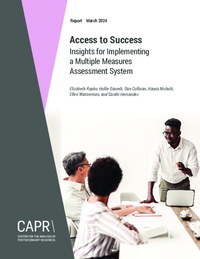Access to Success
Insights for Implementing a Multiple Measures Assessment System

The traditional method of assessing college readiness for incoming college students—using standardized tests like Accuplacer, SAT, or ACT—has been criticized because it may lead to misplacements, especially among students who could succeed in college-level courses but are directed into developmental (remedial) education based solely on their test scores. The consequences of misplacements are particularly concerning because of the increased costs and time associated with participation in developmental education.
A growing body of research advocates multiple measures assessment (MMA) as an alternative to traditional placement systems. MMA uses alternative performance indicators—such as high school grade point average or other transcript information—to predict more accurately whether students can be successful in college-level courses. Center for the Analysis of Postsecondary Readiness (CAPR) researchers from the Community College Research Center and MDRC sought to assist colleges and states nationwide with the adoption and implementation of MMA practices. As part of these efforts, CAPR initiated the Expanding the Adoption of Multiple Measures Assessment and Building the Research Base study, which involved working intensively with colleges in Arkansas and Texas to improve their ability to adopt and expand MMA placement systems.
The findings in this report are derived from implementation interviews with institutional leaders, administrators, faculty members, and advisers from 12 two- and four-year colleges in Arkansas and Texas. The report highlights the roles of key actors in the adoption of MMA and the important role that state context and policies played in implementation. It also reveals the challenges that colleges had to overcome during implementation, such as obtaining staff support, managing student data, and ensuring sufficient staffing. The study’s implementation interviews and cost analysis aimed to answer three research questions:
- What is the design of the MMA system at each college?
- How are colleges adopting MMA practices? What conditions facilitate or hinder the implementation of an MMA system?
- In each state, what is the average cost, per college, of expanding and implementing MMA systems at the time of the implementation study? What is the average cost in each personnel category?






